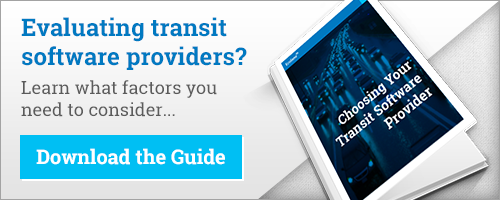As public transportation continues to play a more immersive role in today’s society, transit providers must adopt the necessary tools, resources, and systems to effectively accommodate and support growing demands. However, with that comes the added time that transit directors must allocate towards evaluating, analyzing, and selecting the technologies that will ultimately help them achieve a more efficient and effective transit operation.
Although this may seem like standard practice, it is important for transit directors to have a basic understanding of what to expect from a demo, and to understand the difference between a successful demo and an unsuccessful demo.
What You Should Expect to See During a Transit Software Demo
At a high level, the purpose of a transit software demo is to give potential customers a tangible, inside look into what life would be like if they were to implement a particular solution into their infrastructure. In most cases, this will consist of a salesman or software engineer walking through the transit software’s basic functionality, and highlighting various capabilities and benefits that can be realized. For transit providers, this will likely include how the software schedules and tracks trips, how it aligns with various client needs, and how to best leverage reporting tools.
With that said, it’s important to realize that no two transit agencies are the same; each has its own unique business needs and requires its own systems and tools to support it. Meaning, transit software demos should not take a canned, out-of-the-box, one-size-fits-all approach. Each demo should have a degree of customization that specifically addresses a transit agency’s current challenges, needs, or wants.
A Successful Demo vs. an Unsuccessful Demo
It may seem like somewhat of an arbitrary distinction due to the fact that a software demo either leads to a purchase or it doesn’t. However, regardless of the outcome, there are significant differences between a successful and an unsuccessful transit software demo.
- The first indication is the willingness of the person presenting the demo to listen to and understand the current operational hindrances or challenges faced by their potential client, and to set clear expectations around what they will receive or gain from the demo before beginning. Without a strong understanding of why a prospect is evaluating a particular software solution, it is virtually impossible to deliver a demo that meets their expectations and provides enough value to earn a future purchase.
- The second indication is the ability of the person presenting to align the software demo in a way that fits the prospect’s business model and addresses their major challenges and concerns. In order to truly add value, software demos must focus on the specific tools and capabilities that matter most to the prospect’s business needs. For example, if their agency is currently struggling with cumbersome reporting processes, it’s likely in the best interest of both parties to spend the majority of the time taking a granular look within the software’s reporting function.
The Ecolane Difference
Superior customer service is the foundation on which Ecolane was built, and that same philosophy has been applied to everything we do, including software demos. With the firm belief that in order to find the right solution you must first understand what you’re solving for, Ecolane places an emphasis on gaining the necessary background information prior to presenting a demo. From there, we work to ensure that the demo is focused, concise, and tailored in a way that demonstrates how our software will help your agency gain operational efficiencies and effectiveness while staying within budgetary constraints.
About the Author

Ecolane
Read Ecolane's blog articles for perspective, opinion and information on transit and paratransit issues.
%20(200%20x%20100%20px).png)

